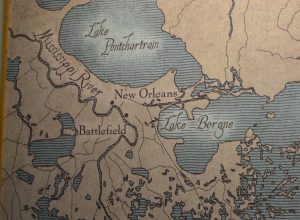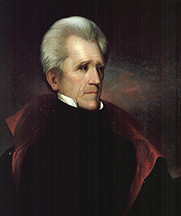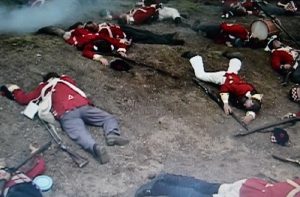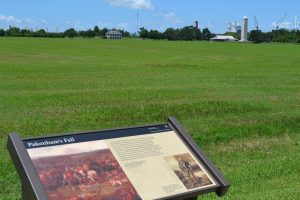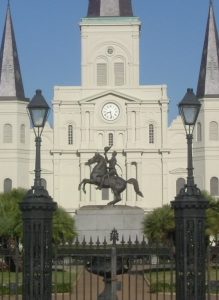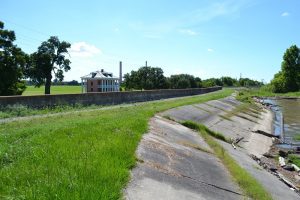
This painting depicts the Battle of New Orleans.The Mississippi River is at the bottom;
swamp at the top.
PAINTING: Jean Hyacinthe Laclotte
Tennesseans have a reputation for toughness. People from Tennessee may have gotten this reputation from the Battle of New Orleans, which took place on January 8, 1815.
We are going to take you there and show you how people from Tennessee, led by Andrew Jackson, shocked the world.
Toward the end of the War of 1812, 12,000 British troops invaded Louisiana — about 6 to 8 thousand of whom are armed soldiers, able to fight.
These were experienced soldiers who had previously fought Napoleon Bonaparte in Europe. They were very confident they would defeat the American troops. The British admiral even said they expected to give the Americans “a complete drubbing.”
The U.S. government ordered General Andrew Jackson’s army to defend New Orleans.
Jackson’s army marched down the Natchez Trace, then to New Orleans. They set up at a sugar plantation about five miles south of the city called Chalmette.
Jackson chose a narrow stretch of land, with the Mississippi River on one side and a swamp on the other.

This scene from the video shown at the visitor’s center shows what it might have looked like when American soldiers were building the rampart
VIDEO: History Channel
He ordered his men to dig a ditch and build a rampart behind it (a rampart is a wall made of dirt and tree trunks). They waited for the British to attack.
The main one came on January 8, 1815.
On paper, this looked like an easy victory for the British.
There were three times more soldiers in the British force than Jackson’s army. And Jackson’s army were not as well organized and trained as the British invaders. They came from different places, and had no experience fighting together as a group.
About 1,300 of them were militiamen from Tennessee, some of whom had fought at Horseshoe Bend.
He had a few hundred soldiers from the U.S. Army.
He had Louisiana militiamen, many of whom spoke French and Spanish, but not English.
He had 62 Choctaw Indians.
He had a group of privateers from Louisiana known as Baratarians.

As this shot from the video reminds us, many of the people who fought on the American side at the Battle of New Orleans were African Americans.
VIDEO: History Channel
Jackson also had nearly 500 free black men fighting for him at New Orleans. In fact, this was the largest use of African-American soldiers in an American battle until the Civil War.
The British force had more soldiers, more experienced soldiers, better trained soldiers and better armed soldiers. But at New Orleans, British soldiers charged into a well-entrenched army. Also, their officers made terrible mistakes planning and executing this battle.
For instance, at the beginning of the day, a large British force crossed the Mississippi River intending to fire guns across the river at the American lines. But they didn’t realize how strong the current of the river was. They were forced way downstream, and the crossing took hours longer than it was supposed to. By the time they were in place, the battle was over.

The “dirty shirts” from Tennessee and Kentucky were better fighters than the British realized.
VIDEO: History Channel
When the main battle began, the British assumed that the weak point of the American line was the company of “dirty shirts”–the men from Tennessee and Kentucky who didn’t have real uniforms. However, many of these “dirty shirts” had fought together for years and were great soldiers.
As the British soldiers marched toward them, the “dirty shirts” gunned them down, led by Generals Coffee and Carroll (for whom Coffee and Carroll counties are named).
A final British mistake saved the day for Jackson’s army. The ladders and bases that the British soldiers had intended to use to climb the ramparts never arrived at the front lines. Soldiers who advanced close to the lines found that they had no way of climbing the rampart. Hundreds were killed while standing in formation, waiting for ladders that never came.
Andrew Jackson’s army crushed the British at the Battle of New Orleans. It was one of the most lopsided battles in history. More than 2,000 British soldiers were killed, wounded, captured or missing. Among the dead was their commanding officer, General Edward Pakenham.
The Americans lost only about 20 men in the main battle.
The British and American soldiers later learned that the peace treaty ending the War of 1812 had already been signed before the Battle of New Orleans. (You see, in those days, it took a long time for news to be delivered.) Because of this, many textbooks downplay the Battle of New Orleans.
However, many people believed that the lopsided nature of this battle ensured that the British would never fight a war against the United States again.
The battle made General Andrew Jackson a national hero, even more so than Horseshoe Bend had done so a year earlier. His leadership in battle had a lot to do with why he was elected president in 1828.
For many years, January 8 was celebrated as a national holiday in the United States.
Finally, here are two other things about the site of the Battle of New Orleans that you might find interesting:
When the battle was fought, the Mississippi River was on one side of the battlefield and a thick, dense swamp on the other.
However, the swamp was “drained” long ago. Today, the Mississippi River is on one side of the battlefield and a highway is on the other.
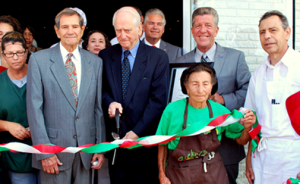
A ribbon cutting for Rocky and Carlos, a restaurant just down the road from the battlefield
PHOTO: St. Bernard Sheriff’s Office
Also, the national battlefield and the surrounding community of Chalmette were hit hard by Hurricane Katrina in 2005. Many houses and businesses (some along streets named for Jackson, Coffee and Carrroll) were abandoned after the hurricane and flood that followed it.
However, the community of Chalmette has begun to make a comeback.
The people there love for visitors to come see the battlefield and have lunch in Chalmette while there.
